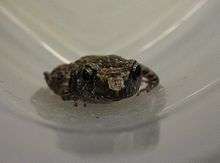Eleutherodactylus cystignathoides
Eleutherodactylus cystignathoides, also known as the Rio Grande chirping frog, Mexican chirping frog, or lowland chirping frog, is a small eleutherodactylid frog.[2][3][4] It is found from the southern United States in Texas, and in the northeastern Mexico in the states of Nuevo León, Tamaulipas, San Luis Potosí, Hidalgo, and Veracruz.[2][3] Its range in Texas has expanded because of transport in potted plants,[1][3] and there is also a likely introduced population in Louisiana.[2]
| Eleutherodactylus cystignathoides | |
|---|---|
 | |
| Scientific classification | |
| Kingdom: | Animalia |
| Phylum: | Chordata |
| Class: | Amphibia |
| Order: | Anura |
| Family: | Eleutherodactylidae |
| Genus: | Eleutherodactylus |
| Subgenus: | Syrrhophus |
| Species: | E. cystignathoides |
| Binomial name | |
| Eleutherodactylus cystignathoides (Cope, 1877) | |
| Synonyms[2] | |
| |
Subspecies
Two subspecies are sometimes recognized,[2] although they are poorly delineated:[5]
- Eleutherodactylus cystignathoides cystignathoides (Cope, 1877) — Rio Grande chirping frog, Mexican chirping frog
- Eleutherodactylus cystignathoides campi (Stejneger, 1915) — Rio Grande chirping frog, Camp's frog
Only Eleutherodactylus cystignathoides campi occurs in Texas.[4][5]
Description
%2C_Liberty_Co.%2C_TX%2C_USA_(30.3193%C2%B0N%2C_94.8190%C2%B0W%2C_21_m.)_13_April_2007.jpg)
Adult males measure 16–24 mm (0.6–0.9 in) and adult females 16–26 mm (0.6–1.0 in) in snout–vent length.[3][6] The snout is pointed and the body is flat and elongated.[4] Tympanum is visible. The finger tips are slightly expanded. Dorsal skin is weakly pustular, that of venter is smooth to areolate.[6] Dorsal coloration is variable (brown, gray, or yellow-green) and includes dark spots. Ventral skin is translucent. The hind limbs have dark crossbars.[4]
Behavior
Both males and females produce calls, which is rare in anurans. Moreover, male and female calls are remarkably similar. A smaller proportion of females compared to males were observed calling in two Mexican populations. Moreover, calling females were, on average, smaller than non-calling females. The function of female calling is not known, but it might function as an advertisement, similarly as the male calls.[7] Males appear to be territorial.[3]
Reproduction
Reproduction is terrestrial and direct, without a free-living larval stage.[1][3][4][7] Under laboratory conditions, eggs are laid just under the soil surface. Clutch size is 5–13 eggs measuring 3–3.5 mm (0.12–0.14 in) in diameter. The eggs hatch as froglets that measure approximately 5–8.5 mm (0.20–0.33 in).[3]
Habitat and conservation
Eleutherodactylus cystignathoides occurs at low elevation coastal plains[3] and at low to moderate elevations in foothills.[1] Individuals can be found in moist shaded vegetation, palm groves, thickets, ditches, resacas, lawns, and gardens.[1][4] Many records are from urban settings. They can hide under cover objects during the day. They have been observed to utilize arboreal perches 0.2–1.5 m (7.9–59.1 in) above the ground.[3]
This species is quite common throughout its range and no major threats to it are known;[1] rather, they appear to thrive in the presence of humans.[3] Its Mexican range includes Sierra del Abra-Tamchipa and El Cielo Biosphere Reserves.[1]
References
- Santos-Barrera, Georgina; Luis Canseco-Márquez & Geoffrey Hammerson (2004). "Eleutherodactylus cystignathoides". IUCN Red List of Threatened Species. 2004: e.T56547A11495468. doi:10.2305/IUCN.UK.2004.RLTS.T56547A11495468.en.
- Frost, Darrel R. (2018). "Eleutherodactylus cystignathoides (Cope, 1877)". Amphibian Species of the World: an Online Reference. Version 6.0. American Museum of Natural History. Retrieved 7 September 2018.
- "Eleutherodactylus cystignathoides". AmphibiaWeb. University of California, Berkeley. 2018. Retrieved 7 September 2018.
- "Rio Grande Chirping Frog Eleutherodactylus cystignathoides". Herps of Texas. University of Texas at Austin. Retrieved 7 September 2018.
- Crother, Brian I., ed. (2017). Scientific and Standard English Names of Amphibians and Reptiles of North America North of Mexico, with Comments Regarding Confidence in our Understanding (PDF). Herpetological Circular. 43 (8th ed.). Shoreview, MN: Society for the Study of Amphibians and Reptiles. p. 11. ISBN 978-1-946681-00-3.
- Lynch, J. D. (1970). "A taxonomic revision of the leptodactylid frog genus Syrrhophus Cope". University of Kansas Publications, Museum of Natural History. 20: 1–45. doi:10.5962/bhl.part.2809.
- Serrano, José M & Penna, Mario (2018). "Sexual monomorphism in the advertisement calls of a Neotropical frog". Biological Journal of the Linnean Society. 123 (2): 388–401. doi:10.1093/biolinnean/blx141.
| Wikimedia Commons has media related to Eleutherodactylus cystignathoides. |
